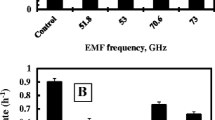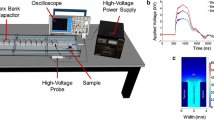Abstract
Energy medicine (EM) provides a new medical choice for patients, and its advantages are the noninvasive detection and nondrug treatment. An electromagnetic signal, a kind of EM, induced from antibiotic coupling with weak, extremely low-frequency pulsed electromagnetic fields (PEMFs) is utilized for investigating the growth speed of Escherichia coli (E. coli). PEMFs are produced by solenoidal coils for coupling the electromagnetic signal of antibiotics (penicillin). The growth retardation rate (GRR) of E. coli is used to investigate the efficacy of the electromagnetic signal of antibiotics. The E. coli is cultivated in the exposure of PEMFs coupling with the electromagnetic signal of antibiotics. The maximum GRR of PEMFs with and without the electromagnetic signal of antibiotics on the growth of E. coli cells in the logarithmic is 17.4 and 9.08 %, respectively. The electromagnetic signal of antibiotics is successfully coupled by the electromagnetic signal coupling instrument to affect the growth of E. coli. In addition, the retardation effect on E. coli growth can be improved of by changing the carrier frequency of PEMFs coupling with the electromagnetic signal of antibiotics. GRR caused by the electromagnetic signal of antibiotics can be fixed by a different carrier frequency in a different phase of E. coli growth.









Similar content being viewed by others
References
Ernst, E., & Cassileth, B. R. (1998). The prevalence of complementary/alternative medicine in cancer: A systematic review. Cancer, 83, 777–782.
White House Commission on complementary and alternative medicine policy. www.whccamp.hhs.gov March 2002. Accessed 20 July 2006.
Ernest, E. (1996). Complementary medicine: An objective appraisal. Oxford: Butterworth-Heinemann.
Hill, F. J. (2003). Complementary and alternative medicine: the next generation of health promotion, Health Promotion International, vol. 18(3). Oxford University Press; pp. 265–72.
National Center for Complementary and Alternative Medicine (NCCAM) of National Institutes of Health (NIH) in the United States What is Complementary and Alternative Medicine? http://nccam.nih.gov/health/whatiscam/. Accessed May 2013.
National Center for Complementary and Alternative Medicine (NCCAM). Expanding horizons of healthcare: Five-year strategic plan, 2001–2005. www.nccam.nih.gov/about/plans/fiveyear/index.htm. Accessed May 2013.
Ding, D., & Dong, X. J. (2010). Research on QiYuan theory for law of cause of disease and pathogens is of cardialgia caused by obstruction of Qi in the chest. Journal of Changchun University of Traditional Chinese Medicine, 26(2), 169–170.
Oschman, J. L. (2000). Energy medicine: The scientific basis. Edinburgh: Churchill Livingstone.
Benveniste, J., Jurgens, P., & Aissa, J. (1996). Digital recording/transmission of the cholinergic signal. FASEB Journal, 10, A1479.
Benveniste J, Guillonnet D (2003) Method, system and device for producing signals from a substance biological and/or chemical activity. US Patent, N 6 541, 978 B1.
Tadevosyan, H., Kalantaryan, V., & Trchounian, A. (2011). Low intensity electromagnetic irradiation with 70.6 and 73 GHz frequencies affects Escherichia coli growth and changes water properties. Cell Biochemistry and Biophysics, 60, 275–281.
Tadevosyan, H., Kalantaryan, V., & Trchounian, A. (2008). Extremely high frequency electromagnetic radiation enforces bacterial effects of inhibitors and antibiotics. Cell Biochemistry and Biophysics, 51, 97–103.
Xu, Z., Xiaoli, L., Leiting, P., & Imshik, L. (2010). Magnetic fields at extremely low-frequency (50 Hz, 0.8 mT) can induce the uptake of intracellular calcium levels in osteoblasts. Biochemical and Biophysical Research Communications, 396, 662–666.
Luo, M. Y., Song, K., Zhang, X., & Lee, I. (2009). Mechanism for alternating electric fields induced-effects on cytosolic calcium. Chinese Physics Letters, 26, 1–4.
Montagnier, L., Aissa, J., Ferris, S., Montagnier, J. L., & Lavallee, C. (2009). Electromagnetic signals are produced by aqueous nanostructures derived from bacterial DNA sequences. Interdisciplinary Sciences Computational Life Sciences, 1, 81–90. doi:10.1007/s12539-009-0036-7.
Simko′, M., & Mattsson, M. O. (2004). Extremely low frequency electromagnetic fields as effectors of cellular responses in vitro: Possible immune cell activation. Journal of Cellular Biochemistry, 93, 83–92.
Gaafar, E.-S. A., Hanafy, M. S., Tohamy, E. Y., & Ibrahim, M. H. (2008). The effect of electromagnetic field on protein molecular structure of E. coli and its pathogenesis. Romanian Journal of Biophysics, 18(2), 145–169.
Roychoudhury, S., Jedlicka, J., Parkanyi, V., Rafay, J., Ondruska, L., Massanyi, P., et al. (2009). Influence of a 50 Hz extra low frequency electromagnetic field on spermatozoa motility and fertilization rates in rabbits. Journal of Environmental Science and Health Part A Toxic/Hazardous Substances and Environmental Engineering, 44, 1041–1047.
Fojt, L., Strašák, L., Vetterl, V., & Šmarda, J. (2004). Comparison of the low frequency magnetic field effects on bacteria Escherichia coli, Leclercia adecarboxylata and Staphylococcus aureus. Bioelectrochemistry-Proceedings of the XVIIth International Symposium on Bioelectrochemistry and Bioenergetics, 63(1–2), 337–341.
Fojt, L., Strašák, L., Vetterl, V., & Šmarda, J. (2005). Effects of 50 Hz magnetic fields on the viability of different bacterial strains. Electromagnetic Biology and Medicine, 24, 293–300.
Fojt, L., Strašák, L., Vetterl, V., & Šmarda, J. (2007). Effect of electromagnetic fields on the denitrification activity of Paracoccus denitrificans. Bioelectrochemistry, 70, 91–95.
Fojt, L., Strašák, L., Vetterl, V., & Šmarda, J. (2009). 50 Hz magnetic field effect on the morphology of bacteria. Micron, 40, 918–922.
Frahma, J., Mattssona, M. O., & Simkóa, M. (2010). Exposure to ELF magnetic fields modulate redox related protein expression in mouse macrophages. Toxicology Letters, 192(3), 330–336.
Belyaev, I. Y., & Alipov, E. D. (2001). Frequency-dependent effects of ELF magnetic field on chromatin conformation in Escherichia coli cells and human lymphocytes. Biochimica et Biophysica Acta, 1526, 269–276.
Kroupová, J., Bártová, E., Fojt, L., Strašák, L., Kozubek, S., & Vetterl, V. (2007). Low-frequency magnetic field effect on cytoskeleton and chromatin. Bioelectrochemistry, 70(1), 96–100.
Liboff, A. R. (2012). Electromagnetic vaccination. Medical Hypotheses, 79, 331–333.
Author information
Authors and Affiliations
Corresponding author
Rights and permissions
About this article
Cite this article
Ke, YL., Chang, FY., Chen, MK. et al. Influence of Electromagnetic Signal of Antibiotics Excited by Low-Frequency Pulsed Electromagnetic Fields on Growth of Escherichia coli . Cell Biochem Biophys 67, 1229–1237 (2013). https://doi.org/10.1007/s12013-013-9641-5
Published:
Issue Date:
DOI: https://doi.org/10.1007/s12013-013-9641-5




